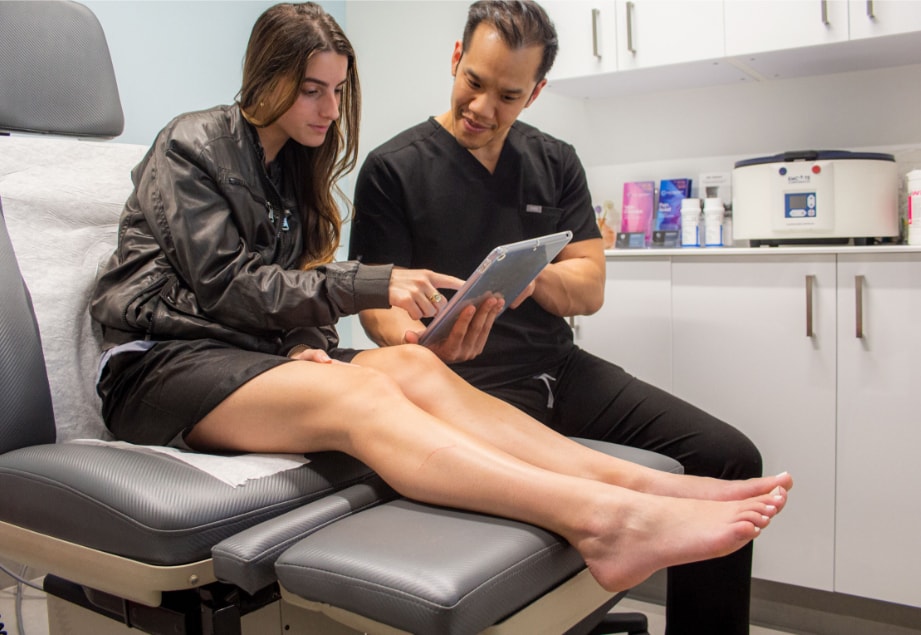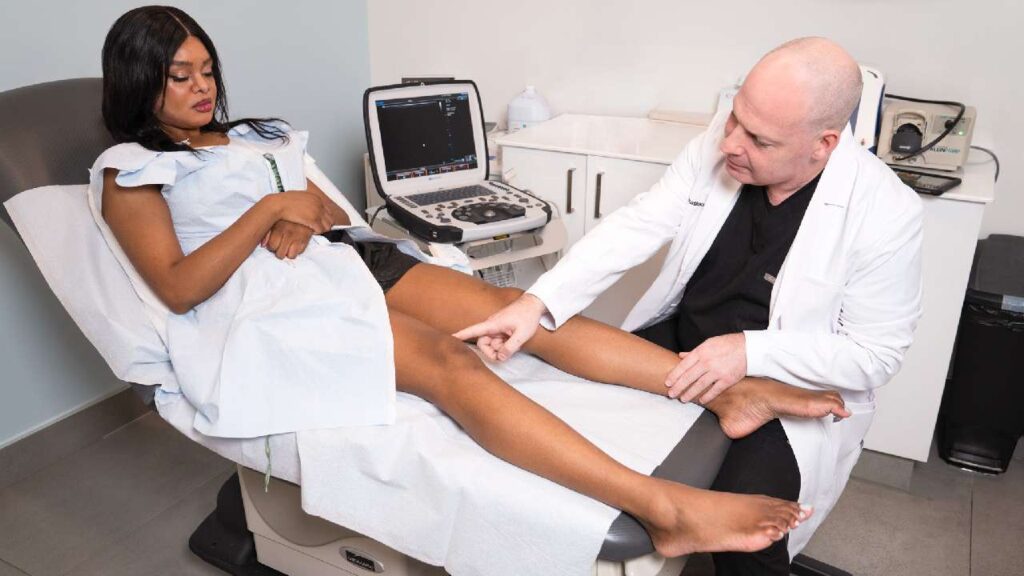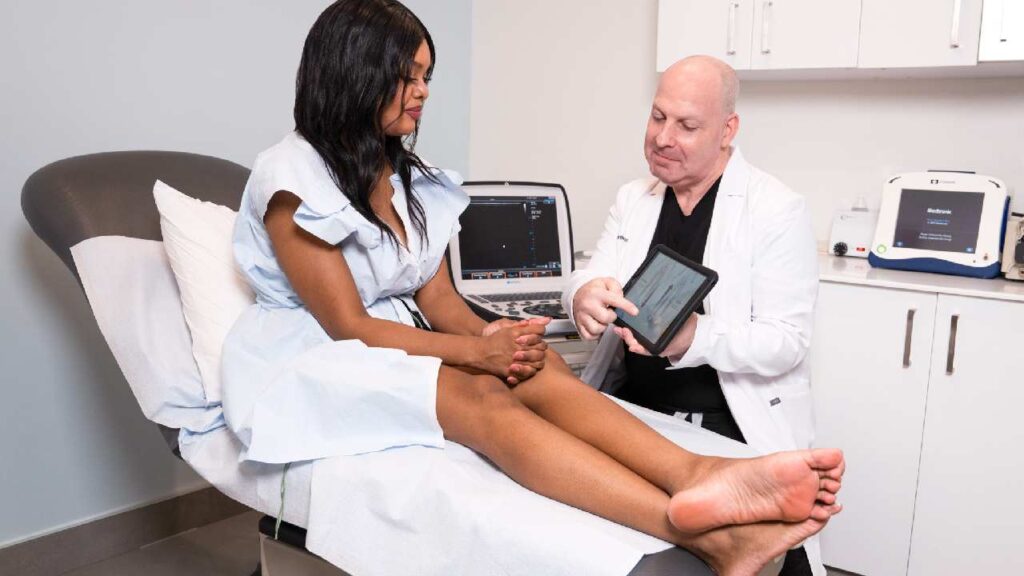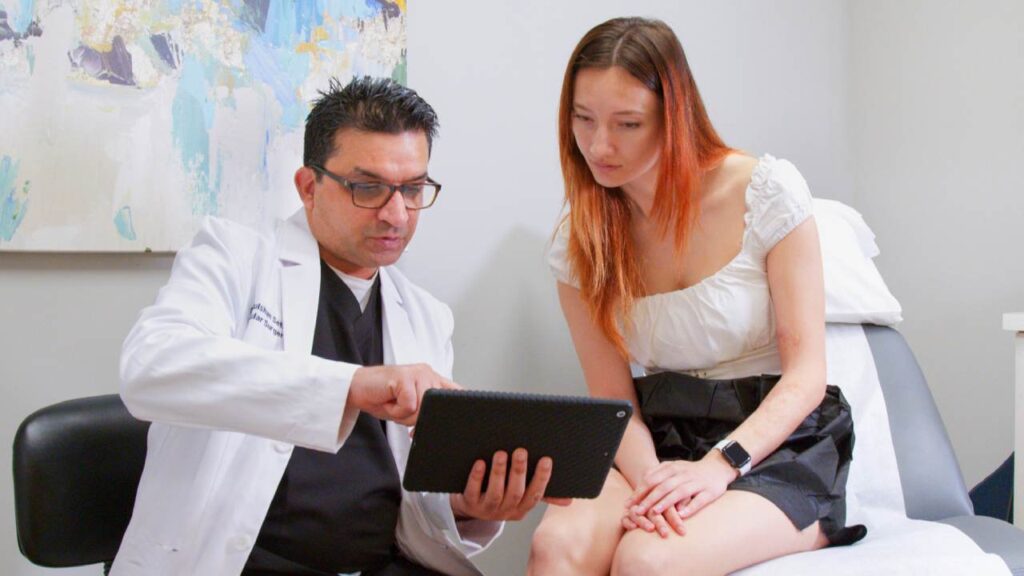How Long Does Spider Vein Treatment Last with Lasers?
The duration of laser treatment for spider veins depends on a few variables. First, what caused the spider vein? Second, what type of laser is used on it? Third, what type of specialist administered treatment? Book an appointment with a vein doctor, not a cosmetic vein specialist, since successful spider vein treatment often requires more than an aesthetic procedure. Some spider veins can be treated through the skin, with devices like pulsed dye lasers. These work best for facial spider veins near the surface of thin skin. They often stem from sun damage, skin injury, aging, and medication.
But spider veins in the legs are commonly caused by valve failure in a deeper vein. This can become a long-term problem called Chronic Venous Insufficiency. Leg veins are often deeper and larger than facial veins. Heating a laser enough to penetrate thicker skin would cause damage to the skin. So, spider veins in the legs often require a laser that’s inserted through the skin and placed directly on the vein. This is called endovenous laser ablation.
Do spider veins come back after laser treatment? Not if they’re treated correctly. But if a spider vein is administered surface treatment, when there’s valve failure in deeper blood vessels, more spider veins can form. In addition, if a vein specialist fails to treat the right vein, or the entire length of the damaged area, the spider vein might persist. You can avoid these outcomes by choosing a board certified vein doctor with ultrasound training. They’ll identify and treat the source of the spider vein, and use Duplex Ultrasound guidance to observe endovenous laser treatments and ensure the vein is closed.
How Long for Spider Veins to Disappear After Treatment?
Lasers close spider veins instantly, so they’re destroyed right away. But the heat essentially cauterizes the vein, so it takes a little time for it to shrink from sight. Depending on the size of the vein and the laser that was used, results can appear in a week or take up to a couple of months. When the vein doctor treats spider veins, blood is rerouted into other veins. The treated vein shrinks and is harmlessly reabsorbed by the body.

Can Veins Recur After Laser Spider Vein Treatment Recovery?
As mentioned, a spider vein recurrence is possible if it wasn’t adequately treated. Veins that stem from Chronic Venous Insufficiency require the doctor to address that issue, in order to prevent more spider veins. And veins that were given a surface treatment when they required a more in-depth approach, might not be successfully closed. Spider veins don’t recur after proper laser spider vein treatment. They are permanently sealed shut and removed from circulation. Choose a vein doctor who specializes in Duplex Ultrasound procedures to prevent a recurrence of spider veins.
Are There Blisters After Laser Vein Treatment?
Laser spider vein treatment recovery is quick and easy, and it doesn’t require time off work. However, some patients have mild, post-procedural skin irritation. In rare cases, surface laser treatments can cause blisters. Endovenous laser ablation does not cause blisters, because it’s not applied to the skin. If you have sensitive skin and need a surface treatment, your vein doctor might use sclerotherapy instead. But blisters are not dangerous unless they become infected when you scrape them. They will heal on their own. Do not “pop” the blister. Keep it clean and apply Vaseline or Neosporin if your doctor advises.
Is There Bruising After Laser Treatment of Spider Veins?
Some patients experience redness or bruising post laser treatment for spider veins. This is common and rarely cause for concern. The duration of bruising varies since some people bruise more easily or substantially than others. If you develop a sudden red spot that is warm or streaky, and accompanied by a fever, call your doctor to rule out infection or blood clot. These complications are exceedingly rare but should be treated promptly.
Can Varicose Veins Return After Treatment?
If you have spider veins, you might also have varicose veins. They both run in families, and they’re both caused by Chronic Venous Insufficiency. So, you might be wondering if varicose veins can return after treatment too. Varicose veins almost always require a treatment that goes beneath the surface. Most varicosities in leg veins are larger than spider veins, so a surface laser might not suffice.
Vein doctors can use steam vein sclerosis, sclerotherapy, vein adhesives, or tiny catheters that administer lasers or radiofrequency directly to the vein. These are all minimally invasive procedures that take 15-30 minutes. As with spider vein treatment, choosing the right method is essential to successfully treating varicose veins. The doctor must also check for venous insufficiency, so the patient won’t keep developing varicose veins.
Does Bilateral Varicose Veins Surgery Prevent Recurrence?
Some patients assume surgery is the best way to prevent a recurrence of varicose veins. However, surgery is almost never used on spider veins, and varicose veins rarely require it. Bilateral varicose veins surgery was once common. But the development of minimally invasive vein treatments has largely replaced surgery. Vein specialists can now close veins inside the body, rather than cutting them out. Do veins grow back after surgery? Studies show that surgical removal of varicose veins has a higher revascularization rate than minimally invasive treatments.
What’s the Best Method of Bilateral Varicose Veins Treatment?
A small number of patients require surgery. For most patients, a minimally invasive approach is better. If you need bilateral varicose veins treatment, a less invasive method prevents you from having to stay off both feet and postpone responsibilities. Endovenous laser and radiofrequency treatments close veins through tiny incisions, so you can resume your usual routine, even driving yourself home. Non-surgical tactics have less risk, expense, complications, and downtime. If possible, opt for a surgical alternative.
What’s the Radiofrequency Ablation Varicose Veins Success Rate?
Endovenous laser ablation has an incredibly high success rate. Most studies find it 98% successful over a 12-month term. The radiofrequency ablation varicose veins success rate is equally high. This procedure is performed like endovenous laser treatments, but doctors use radiofrequency instead of lasers to generate heat. Radiofrequency isn’t quite as hot as laser energy, so it’s more comfortable for some patients.
What Prevents Recurrence After Varicose Vein Treatment?
If you want to prevent a recurrence after spider or varicose vein treatment, choose a board certified, minimally invasive vein doctor. These physicians don’t just treat spider veins and varicose veins at the surface; they also treat the underlying cause. And they do it without surgery. Treating the cause, using ultrasound guidance, and avoiding unnecessary surgery are key components of successful varicose vein treatment.
How Do You Maintain the Look of New Legs from Vein Treatment?
While treating varicose veins and spider veins is often more than a cosmetic procedure, it does produce cosmetic benefits. So, how do you preserve the skin’s new appearance after treating leg veins? Maintain a healthy weight and active lifestyle. Avoid sitting or standing for long periods of time. Elevate your legs while resting. And wear compression stockings if your doctor recommends them. The best thing about vein treatment is that your vein damage is gone for good. These steps will optimize your circulation to prevent future issues in other blood vessels.





